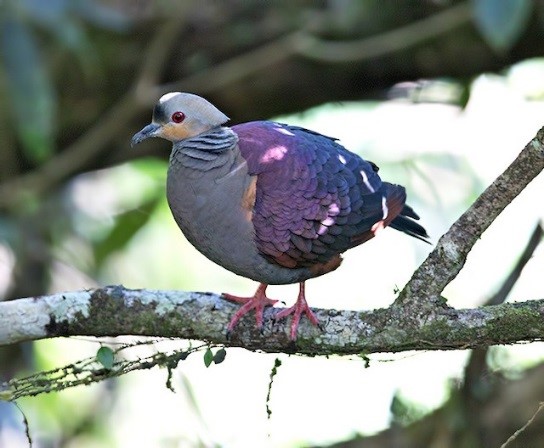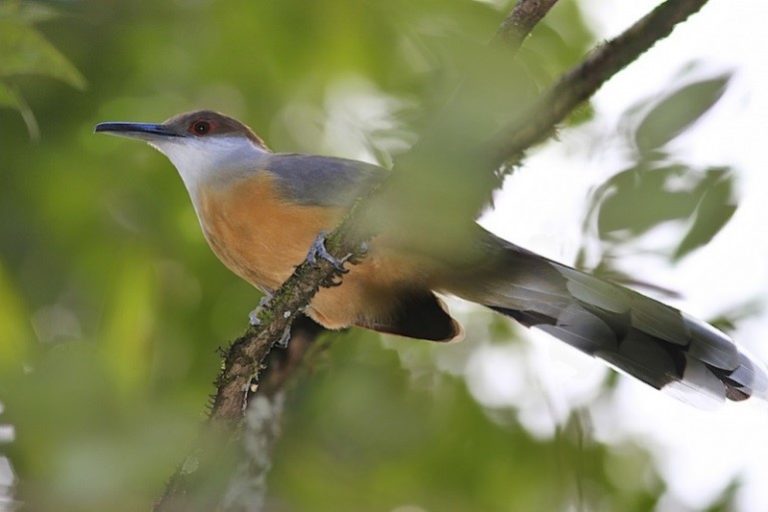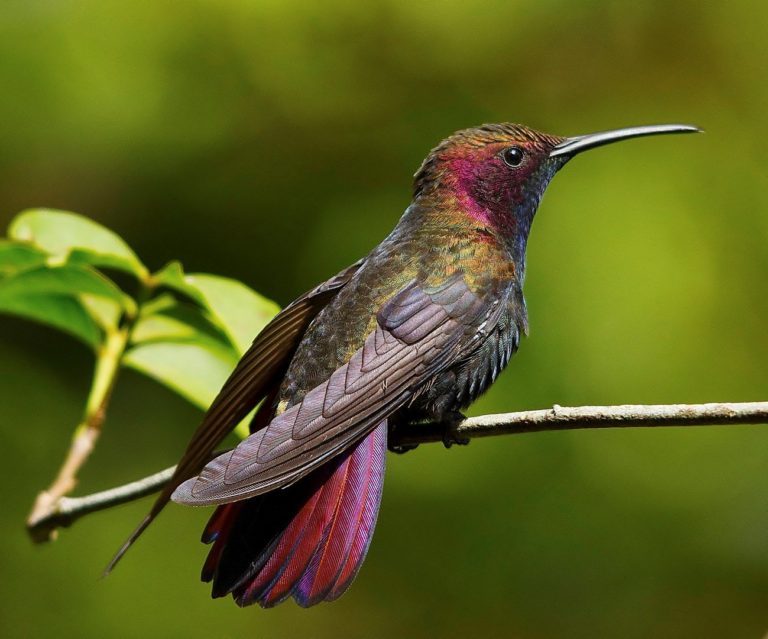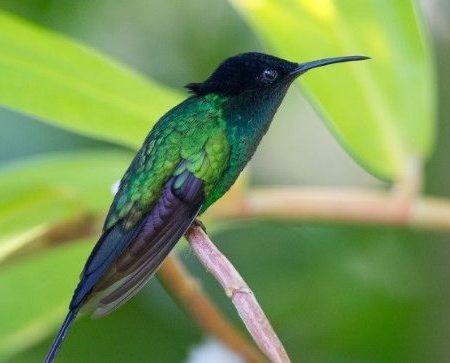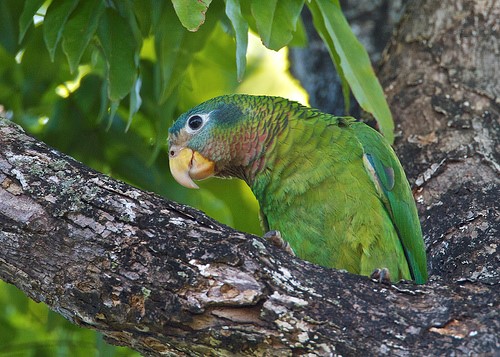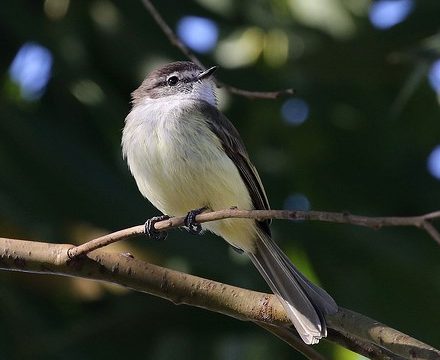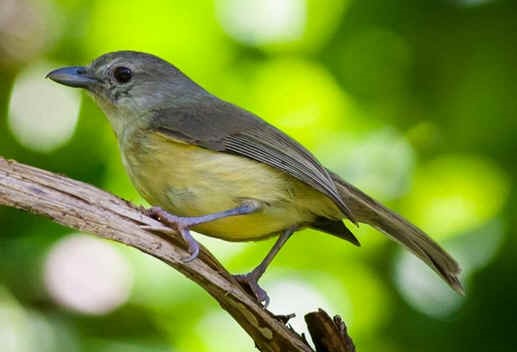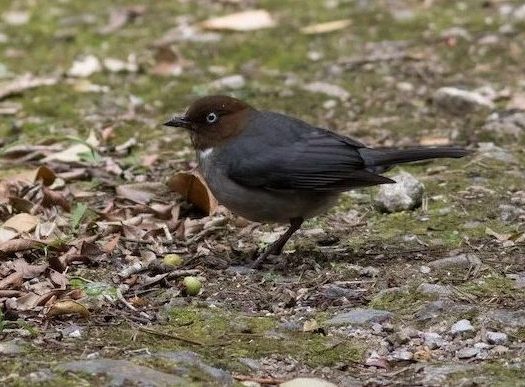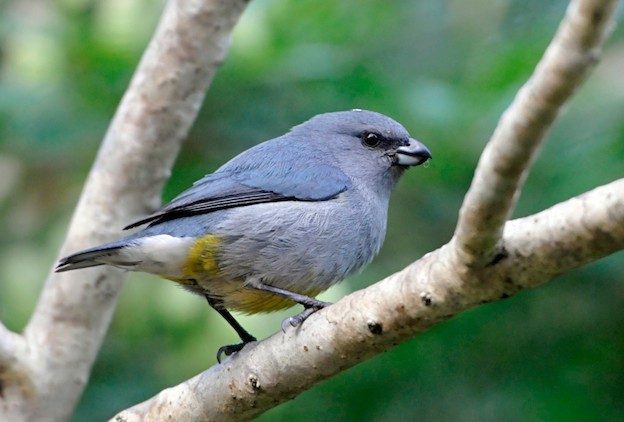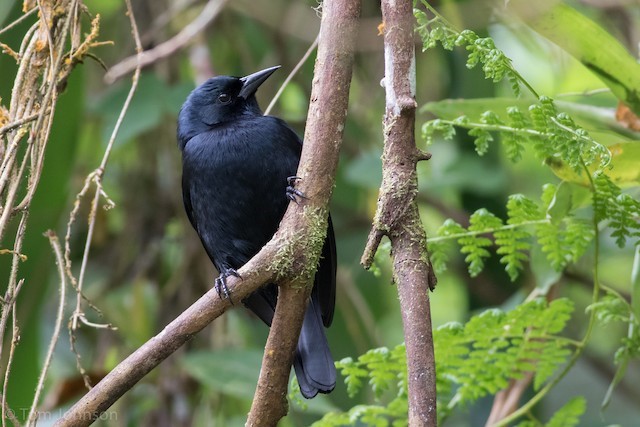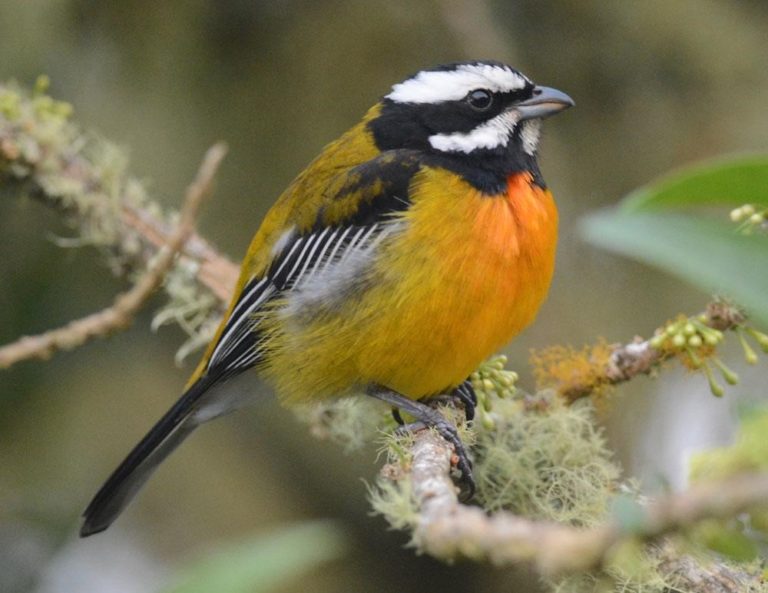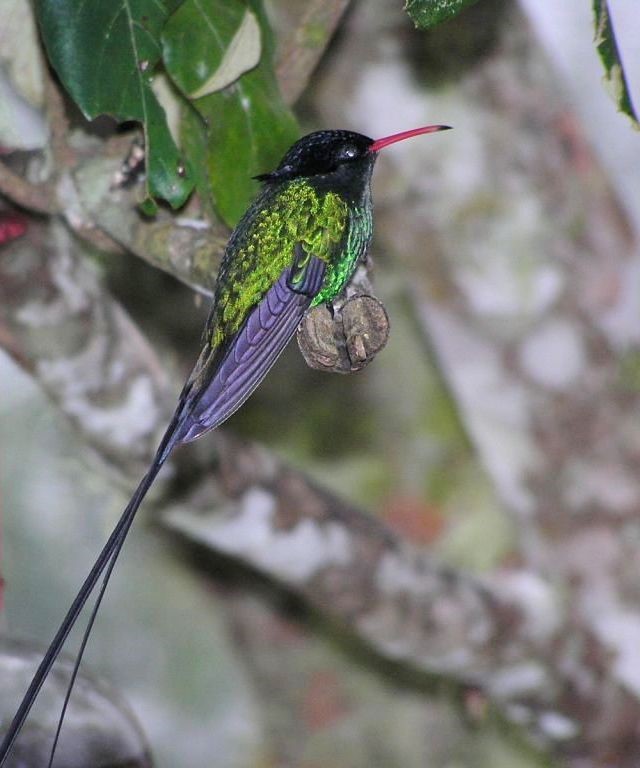
Red-billed Streamertail, male. © Jan van den Broeck
Jamaica has approximately 30 endemic bird species, the most of any island in the Caribbean and the 16th highest total among countries worldwide. Two additional endemic species, the Jamaican Petrel and Jamaican Pauraque, were last seen in the 1800s and are presumed extinct, although some optimists still hold out hope for their rediscovery.
Remarkably, it is possible to find all of Jamaica’s endemic birds at a single site in eastern Jamaica, Ecclesdown Road, although one species, the Large Jamaican Elaenia, is very rarely found there and a few others are uncommon. Still, by adding Hardwar Gap to the itinerary, it is possible to find all of Jamaica’s endemics very efficiently. (For general orientation to Jamaica’s main birdwatching sites, see the map below or go to The Avitourist’s Guide to Jamaica.)
Endemic Birds of Jamaica
Ring-tailed Pigeon / Crested Quail-Dove / Chestnut-bellied Cuckoo / Jamaican Lizard-Cuckoo / Jamaican Owl / Jamaican Mango / Red-billed Streamertail / Black-billed Streamertail / Jamaican Tody / Jamaican Woodpecker / Black-billed Parrot / Yellow-billed Parrot / Jamaican Parakeet / Small Jamaican Elaenia / Large Jamaican Elaenia / Jamaican Pewee / Sad Flycatcher / Rufous-tailed Flycatcher / Jamaican Becard / Jamaican Vireo / Blue Mountain Vireo / Jamaican Crow / “Jamaican Solitaire” / White-eyed Thrush / White-chinned Thrush / Arrowhead Warbler / Orangequit / Yellow-shouldered Grassquit / Jamaican Spindalis / Jamaican Oriole / Jamaican Blackbird / Jamaican Euphonia
Ring-tailed Pigeon (Patagioenas caribaea): The Ringtail, as it is known locally, can be found on most outings in Cockpit Country and the Blue, Port Royal, and John Crow Mountains, but can also be unpredictably difficult to find at times, likely when wandering in search of fruiting trees. Sites where it is usually conspicuous include Windsor, Barbecue Bottom / Burnt Hill Road, Stewart Town, Hardwar Gap, Mavis Bank, Portland Gap, San San, and Ecclesdown Road.
Crested Quail-Dove (Geotrygon versicolor): This spectacular species is shy and localized, but it can often be found in the open at first light in the Hardwar Gap area (Woodside Drive, Catherine’s Peak, Section, and Silver Hill Gap), Stewart Town, Ecclesdown Road, and Marshall’s Pen. Could be chanced upon along almost any trail in Cockpit Country and the eastern mountains, but its retiring habits make it difficult to observe.
Chestnut-bellied Cuckoo (Coccyzus pluvialis): Present at most of the frequently visited forest sites on Jamaica. Among these, the most reliable seem to be Marshall’s Pen, Stewart Town, and Green Castle Estate in Robin’s Bay. Other sites where it is often seen include Rocklands Bird Sanctuary, Windsor, Barbecue Bottom / Burnt Hill Road, Hardwar Gap, San San, and Ecclesdown Road.
Jamaican Lizard-Cuckoo (Coccyzus vetula): A fairly common and widespread, but also secretive and retiring, species that seems to be most consistently observed at San San, Robin’s Bay, Ecclesdown Road, and Marshall’s Pen. It can be found anywhere in the Blue Mountains and Cockpit Country.
Jamaican Owl (Pseudoscops grammicus): The most reliable known sites are Hardwar Gap (especially Woodside Drive), San San, and Marshall’s Pen. Has also been found often at Rocklands Bird Sanctuary, Green Castle Estate in Robin’s Bay and Forres Park Guest House in Mavis Bank. A very large portion of sightings occur on or near hotel properties—due at least in part to the relative ease of detecting it in semiopen areas where visiting birdwatchers stay overnight. Seems to be more active in pre-dawn hours than after dusk.
Jamaican Mango (Anthracothorax mango): Fairly common throughout the island, mainly at low elevations in dry semiopen habitats. Among Jamaica’s frequently visited sites, the most reliable are Rocklands Bird Sanctuary (where it sometimes perches on visitors’ fingers), Treasure Beach, Marshall’s Pen, Portland Ridge, Robin’s Bay, the Hellshire Hills, and San San. Also occurs regularly at many other sites, including hotel grounds.
Red-billed Streamertail (Trochilus polytmus): One of the most ubiquitous woodland and garden birds on Jamaica. Easy to find at most of the frequently visited birdwatching sites, most famously at Rocklands Bird Sanctuary, where it regularly perches on visitors’ fingers.
Black-billed Streamertail (Trochilus scitulus): Readily found along Ecclesdown Road and in San San—especially at the Mockingbird Hill Hotel and Goblin Hill Villas. The town of Bath, inland from Port Morant, is also reliable and much closer to Kingston. Note that the local attraction, Bath Fountain, has a history of self-appointed “guides” aggressively harassing visitors.
Jamaican Tody (Todus todus): Usually present at most of Jamaica’s wooded birdwatching sites: Rocklands Bird Sanctuary, Marshall’s Pen, Robin’s Bay, San San, Ecclesdown Road, and anywhere in the Blue Mountains or Cockpit Country. Typically uses earthen banks for its nest burrows, so it tends to be found near streams, gulleys, road cuts, and other formations that expose surfaces suitable for horizontal excavation.
Jamaican Woodpecker (Melanerpes radiolatus): Easy to find throughout Jamaica, occurring at all the frequently visited sites, including urban sites such as Hope Botanical Garden. Especially observable at Rocklands Bird Sanctuary, where it attends the feeders.
Black-billed Parrot (Amazona agilis): Usually conspicuous at several sites in Cockpit Country: e.g., Windsor, Barbecue Bottom / Burnt Hill Road, and Stewart Town. Ecclesdown Road is also a reliable site. In its core areas, especially around Windsor, it tends to outnumber the more widespread Yellow-billed Parrot. Can also be found at Hope Botanical Gardens in Kingston.
Yellow-billed Parrot (Amazona collaria): Can usually be found at Ecclesdown Road and in Cockpit Country at Windsor, Barbecue Bottom / Burnt Hill Road, and Stewart Town. A small urban population occurs in parks and gardens in the eastern districts of Kingston, where it can often be found at Hope Gardens and around the campus of the University of the West Indies.
Jamaican Parakeet (Eupsittula nana): Naturally endemic to Jamaica, but an introduced population has become established on Hispaniola. Readily found at most of the well visited lowland and foothill sites in Jamaica, such as Rocklands Bird Sanctuary, Stewart Town, Marshall’s Pen, Hope Gardens, Robin’s Bay, San San, Ecclesdown Road, and throughout Cockpit Country.
Small Jamaican Elaenia (Myiopagis cotta): An uncommon, inconspicuous, and easily overlooked resident of humid montane and foothill forests and woodlands. Hardwar Gap is probably the most reliable site, especially the Woodside Track. Other sites where it can often be found include Marshall’s Pen, Stewart Town, San San, and Ecclesdown Road.
Large Jamaican Elaenia (Elaenia fallax): Breeds at upper elevations of the Port Royal and Blue Mountains. When not breeding, disperses to forested habitats at lower elevations across much of the island. The most accessible sites where this species can reliably be found are Hardwar Gap, Silver Hill Gap, and Portland Gap, where it becomes locally common from about April to September. At other times of year, it could possibly be found anywhere in Jamaica, but is generally rare or inconspicuous.
Jamaican Pewee (Contopus pallidus): Locally common in humid montane and foothill forests across Jamaica. Most easily found at Hardwar Gap, Ecclesdown Road, and other sites in the Port Royal, Blue, and John Crow Mountains. Also readily found in much of Cockpit Country, including Stewart Town.
Sad Flycatcher (Myiarchus barbirostris): Happily, this inaccurately named bird is common throughout Jamaica, and can be found at all of the sites frequented by visited birdwatchers, such as Rocklands Bird Sanctuary, Stewart Town, Marshall’s Pen, Robin’s Bay, Hardwar Gap, San San, and Ecclesdown Road.
Rufous-tailed Flycatcher (Myiarchus validus): The largest and most distinctive of Jamaica’s three resident Myiarchus flycatchers. It is fairly common in humid montane and foothill forests and woodlands across Jamaica. Can be found at most well-wooded sites on Jamaica, including Rocklands Bird Sanctuary, Windsor, Stewart Town, Marshall’s Pen, Hardwar Gap, San San, and Ecclesdown Road.
Jamaican Becard (Pachyramphus niger): Fairly common but can be difficult to find outside the breeding season. Often found in edge habitats and semiopen woodlands with mature trees. As with other becards, its nest is a large, suspended, “globular” mass that can sometimes be a helpful clue to finding it. Sites where it is consistently present include Stewart Town, Hardwar Gap, San San, and Ecclesdown Road.
Blue Mountain Vireo (Vireo osburni): Locally common in Jamaica’s eastern mountains. Can be found on most visits to Hardwar Gap, Silver Hill Gap, Portland Gap, and Ecclesdown Road. Scarce elsewhere on the island, but consistently reported from a few sites in Cockpit Country, including Stewart Town, Burnt Hill, and Windsor.
Jamaican Vireo (Vireo modestus): One of the most ubiquitous birds on Jamaica, it can be found at all of the frequently visited sites. Not always easy to lay eyes on, but should be heard on nearly every visit to places such as Rocklands Bird Sanctuary, Stewart Town, Marshall’s Pen, Hardwar Gap, San San, Ecclesdown Road, etc.
Jamaican Crow (Corvus jamaicensis): Fairly common and conspicuous across north-central Jamaica, especially in the region south of Ocho Rios. Among frequently visited sites, it is most reliably found at Stewart Town and Ecclesdown Road—although the latter population may be dwindling. Usually present at Cockpit Country sites such as Barbecue Bottom / Burnt Hill Road and Windsor. It has appeared sporadically at Rocklands Bird Sanctuary and other sites in and around Montego Bay.
“Jamaican Solitaire” (Myadestes genibarbis solitarius): Traditionally considered a subspecies of Rufous-throated Solitaire, but it differs visibly, and genetic studies seem to support classification as a separate species. Breeds mainly at upper elevations of the Blue, Port Royal, and John Crow Mountains. When not breeding—mainly November to March—disperses to a wider range of elevations the length of the island. Easily heard, but not always easy to see, in the early morning at Hardwar Gap and other Blue Mountain sites. It can sometimes be found at other locations, including Ecclesdown Road, San San, and wet forest sites in Cockpit Country.
White-eyed Thrush (Turdus jamaicensis): A common but somewhat elusive resident of humid montane and foothill woodlands across Jamaica. Can usually be found along Ecclesdown Road and at Hardwar Gap and other Blue Mountain sites. Other reliable sites include Marshall’s Pen and San San. Habitually shy and retiring, it is most likely to be seen feeding in the open at dawn and dusk, but it sometimes appears in full view at any time of day.
White-chinned Thrush (Turdus aurantius): Common and easy to find at all of the frequently visited wooded sites on Jamaica. Usually among the more numerous and conspicuous birds present at most locations. Especially abundant at Hardwar Gap. Within Kingston, it can be found at Hope Botanical Gardens and in leafy neighborhoods, often feeding on lawns.
Jamaican Euphonia (Euphonia jamaica): Fairly common at all elevations in wooded and semiopen habitats, including gardens. Readily found at most Jamaican sites frequented by birdwatchers: e.g., Rocklands Bird Sanctuary, Marshall’s Pen, Hardwar Gap, San San, and Ecclesdown Road.
Jamaican Oriole (Icterus leucopteryx): Endemic to two widely separated islands, Jamaica and Isla San Andrés; formerly also on Grand Cayman. Widespread and common in most wooded habitats on Jamaica, including large gardens. Readily found at most of the frequently visited sites, such as Rocklands Bird Sanctuary, Marshall’s Pen, San San, Ecclesdown Road, and throughout Cockpit Country and the Blue Mountains.
Jamaican Blackbird (Nesopsar nigerrimus): An uncommon, localized, and declining resident of wet montane forests with abundant epiphytes. Probably Jamaica’s most endangered endemic bird; may already or soon be confined to the eastern mountains. The best readily accessible site where it can usually be found is Hardwar Gap. Equally reliable, but less convenient, are Silver Hill and Portland Gaps. Can sometimes be found near the crest of Ecclesdown Road.
Arrowhead Warbler (Setophaga pharetra): Locally common in montane and foothills forests and woodlands across Jamaica. Most reliably found at wet highland sites such as Hardwar Gap and Ecclesdown Road. Generally present, but not always conspicuous, at most of Jamaica’s other frequently visited humid woodland sites, such as Rocklands Bird Sanctuary, Stewart Town, Marshall’s Pen, and San San.
Jamaican Spindalis (Spindalis nigricephala): Common in humid forests and open woodlands at all elevations across Jamaica. Can usually be found at wooded sites such as Rocklands Bird Sanctuary, Stewart Town, Marshall’s Pen, Hardwar Gap, San San, Ecclesdown Road, and generally throughout the Blue Mountains and Cockpit Country.
Orangequit (Euneornis campestris): Widespread and common in humid montane and foothill woodlands across Jamaica, down to sea level along the northern coast. Easy to find at several of the frequently visited sites on Jamaica, especially the feeders at Rocklands Bird Sanctuary. Also common at Stewart Town, Hardwar Gap, San San, and Ecclesdown Road.
Yellow-shouldered Grassquit (Loxipasser anoxanthus): Fairly common across Jamaica in all types of wooded areas and edge habitats, including scrub and gardens. Can be found at many of the sites frequented by birdwatchers, but most often seen in brushy woodland or along grassy roadsides in forest, as at Stewart Town, Marshall’s Pen, Hardwar Gap, and Ecclesdown Road.
Jamaica – Orientation Map

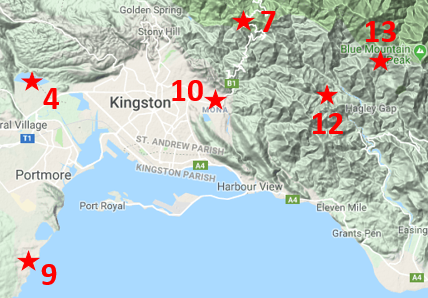
1 – Barbecue Bottom / Burnt Hill Road
2 – Black River Lower Morass
4 – Caymanas Ponds
5 – Ecclesdown Road
6 – Font Hill Nature Reserve
7 – Hardwar Gap
8 – Hector’s River
9 – Hellshire Hills
10 – Hope Gardens
11 – Marshall’s Pen
12 – Mavis Bank
13 – Portland Gap
14 – Portland Ridge
